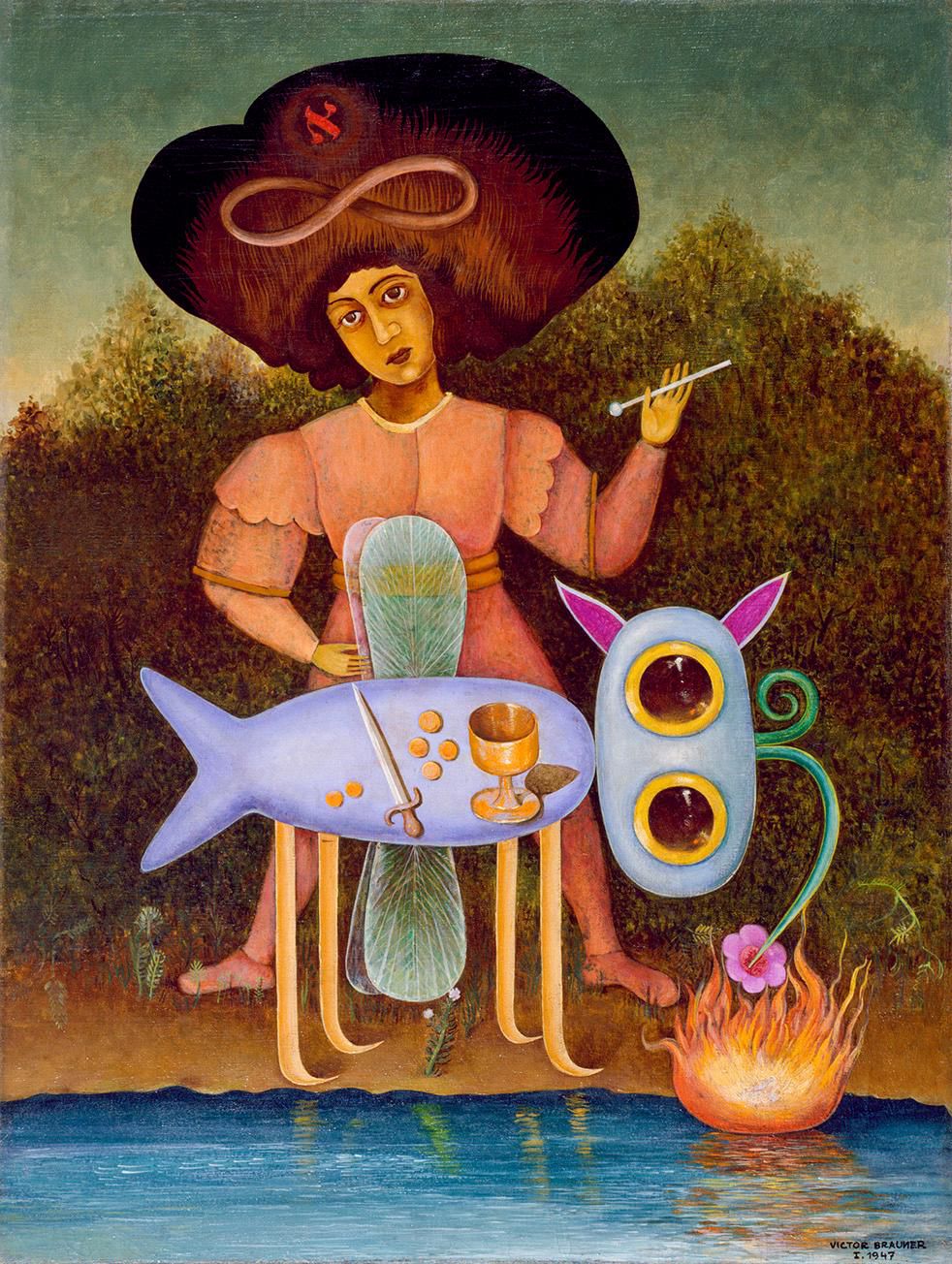
The Victor Brauner who makes the poster.
Estate of Victor Brauner, Peggy Guggenheim Collection, Venice 2022.
There is sorcery in the air! But the latter becomes nowadays quite respectable by one of these reversals of situation of which our time is prodigal. Magic is indeed part of feminism. The unfortunate women once condemned to the stake are today pioneers, not in the field of heating but because of the spark of freedom that they allowed themselves a little too early. So there are a lot of female painters on the walls in the “Surrealism and Magic” exhibition at the Peggy Guggenheim Collection, since everything is written and said in English in this sort of American embassy in Venice. Poor Peggy, she who hated her family across the Atlantic so much, especially her uncle Salomon!
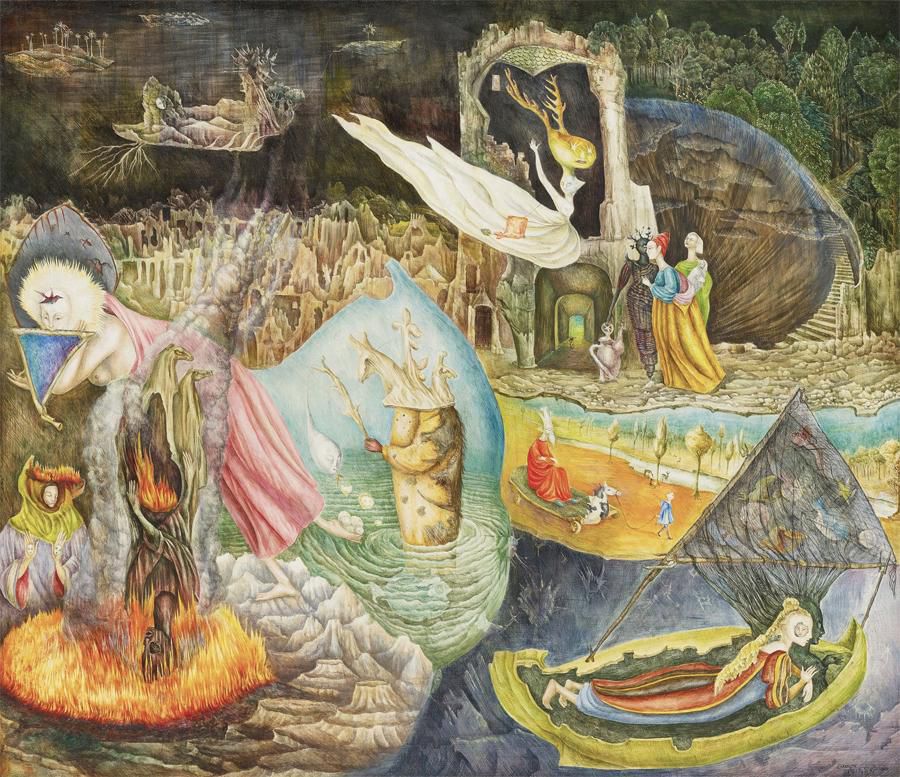
The world according to Leonora Carrington.
Estate of Leonora Carrington, Peggy Guggenheim Collection, Venice 2022.
“Magic is a means of appropriating the unknown by means other than science or religion”, says a sentence at the entrance to the route designed in the new part of the Collection, located on the other side of the interior garden. It dates from 1946. Its words are those of Max Ernst, who remained Peggy’s husband for some time. Freud does not appear very far. The visitor will find here a thought of “Totem or taboo”, the great Sigmund having estimated that “the human imagination can exert a direct impact on external reality.” The inventor of psychoanalysis appears here in tune with the romantics of the 1780s-1830s. One of the first picture rails is a “Study for a portrait of Goethe” by André Masson. The Germanic “Sturm und Drang” is indeed based on intuition and subjectivity…
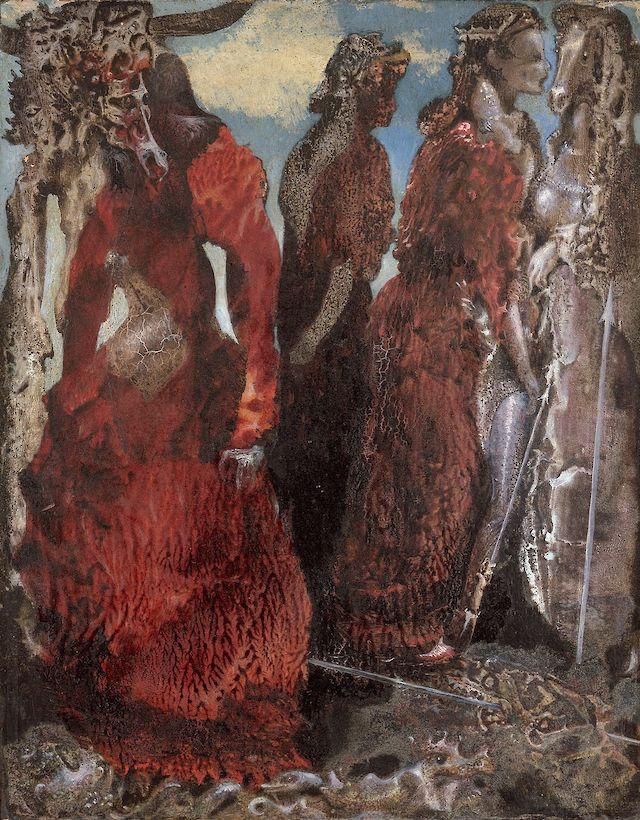
The Antipope by Max Ernst.
Estate of Max Ernst, Peggy Guggenheim Collection, Venice 2022.
From there, the exhibition, designed by Gražina Subelytès in collaboration with the Barberini Museum in Potsdam near Berlin, can sail from Marseille tarots to “exquisite corpses” with touches of alchemy, waves of occultism and many of esotericism. An entire room is dedicated to Kurt Seligmann from Basel, whom his hometown hardly ever shows. A time established in the United States, where he arrived before the other surrealists in 1941, was not the latter the author of the “Mirror of magic”, published in New York in 1948? The whole Western world is seen here studied, while the supernatural constituted for a quarter of a century a fundamental inspiration for the movement “coached” by André Breton. A little further, the Cuban Wilfrido Lam brings “the religious practices of the African diaspora”, in other words voodoo. All that’s missing is the philosopher’s stone. I reassure you right away. This mineral, after which alchemists of all kinds have run in vain, is present in Peggy’s with a painting by Victor Brauner.
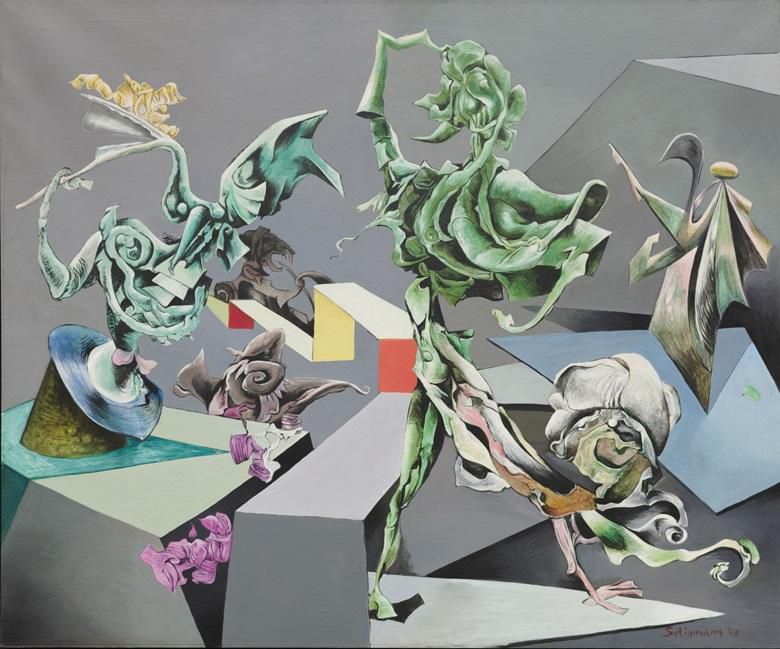
One of the paintings presented by Kurt Seligmann from Basel.
Estate of Kurt Seligmann, Peggy Guggenheim Collection, Venice 2022.
So much for the masculine side, which brings fundamental works to the public. Especially from Max Ernst, who finds himself here a little at home. There are many gentlemen, from Giorgio de Chirico, seen as a sort of adopted grandfather, to Dalí, represented by a single piece. The Peggy Guggenheim Collection is not very Dalí. The anthology appears splendid, but it does not offer anything really original, nor especially of unknown. Innovation therefore occurs at the female level. The commissioner has selected a number of names, starting with that of Leonora Carrington (1917-2011). Obvious if we know that the current Biennale, which I will soon talk to you about, was dedicated by its curator Cecilia Alemani to the British. A meticulous artist, often inspired, but all the same a little minor compared to the key figures of surrealism. I would prefer Kay Sage (1898-1963), Remedios Varo (1908-1963), even Leonor Fini (1908-1996), before Argentina wasted his talent. Note in passing that Toyen (1902-1980), whom I spoke to you about recently on the occasion of his Parisian retrospective at the City’s Museum of Modern Art, remains absent here. It’s as if the Czech never existed! Ditto for our Meret Oppenheim.
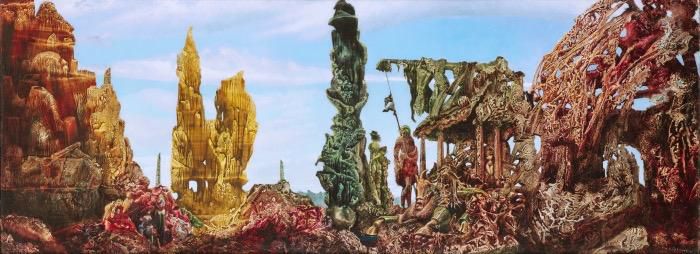
“Europe after the rain”. The war reviewed by Max Ernst.
Estate of Max Ernst, Peggy Guggenheim Collection, Venice 2022.
So. It is in my opinion allowed to think that the idea of women who are more intuitive, and therefore closer to magic, is part of the new stereotypes. It seems that one can hardly live without them. But the essence is undoubtedly elsewhere. The curator has managed to obtain capital loans (capital like sins, etc.) from important, often Israeli, museums. Everything looks good hooked up. Well lighted. There are many explanations, and therefore justifications on the cartels. No one is forcing the public to read them to the end. The route is also concise. The space available is not unlimited. After the large room housing in particular the Yves Tanguy before and after the war, it’s over (like Leonor!). Better too little than too much. And it should be remembered that here the permanent spaces remain very visited, with the set brought together by Peggy and that, bequeathed in 2012, by the Schulhof couple. And don’t forget the “shop”, in which the public (mostly English-speaking) is asked to spend! A “shop” takes time.
Practice
“Surrealism and Magic,” Peggy Guggenheim Collection, 701-704, Dorsoduro, Venice, until September 26. Such. 0 039 041 240 54 11, Site www.guggenheim-venice.it Open every day, except Tuesday, from 10 a.m. to 6 p.m. Reservation recommended. You exchange your “voucher” (or voucher) for a ticket at a cash desk. Everything is going very fast. Otherwise, there is the outside line, which can be quite long.
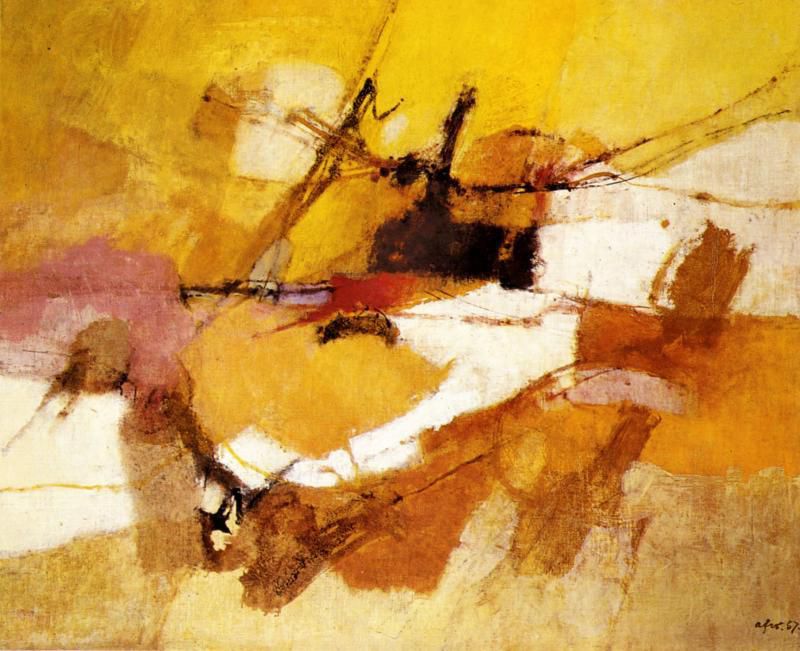
“Yellow Country”. The Afro who makes the poster. It belongs to Beaubourg, who never shows it.
Succession Afro, RMN, Paris 2022.
The Ca’Pesaro shows Afro. An unknown Italian painter from the 1950s and 1960s. To be discovered in a very empty palace…
There is no one (or almost) to see this, and I find it very unfair. On the Grand Canal, the Ca’Pesaro remains empty, while it pays homage to Afro (1912-1974). This is one of the painters who marked Italy in the 1950s and 1960s, characterized by internationalization and the economic boom. Afro Basaldella (because Afro was indeed his real first name, given by his father who had attached Libia to it in order to properly arch the annexation of Libya in 1911) participated in almost all the Venice Biennials. It was collected by Peggy Guggenheim, installed in 1948 on the Lagoon. The Friulian (he was born in Udine) finally conquered success in the USA in 1950 thanks to the gallery owner Catherine Viviano (died at 103 in 1992!). A kind of faultless course.
The final part
The current retrospective remains in fact partial. The public (or to be fair its absence) is only entitled to the second part of a career that began in the early 1930s. Only a self-portrait from 1936, above all chosen to show the head of the young artist , bears witness to the figurative years. Graduating in 1931, Afro lived through the years of fascism, which were politically more restrictive than those of the fine arts. If one of his decorations was withdrawn from a school, because insufficiently triumphalist, the beginner will have been shown by the most prestigious pre-war galleries, such as Il Millione or La Cometa. He will have been accepted at the Mussolinian Biennials, before becoming a member of the Resistance. The man even received orders for the EUR, near Rome, where the (eventually canceled) 1942 World’s Fair was to be held.
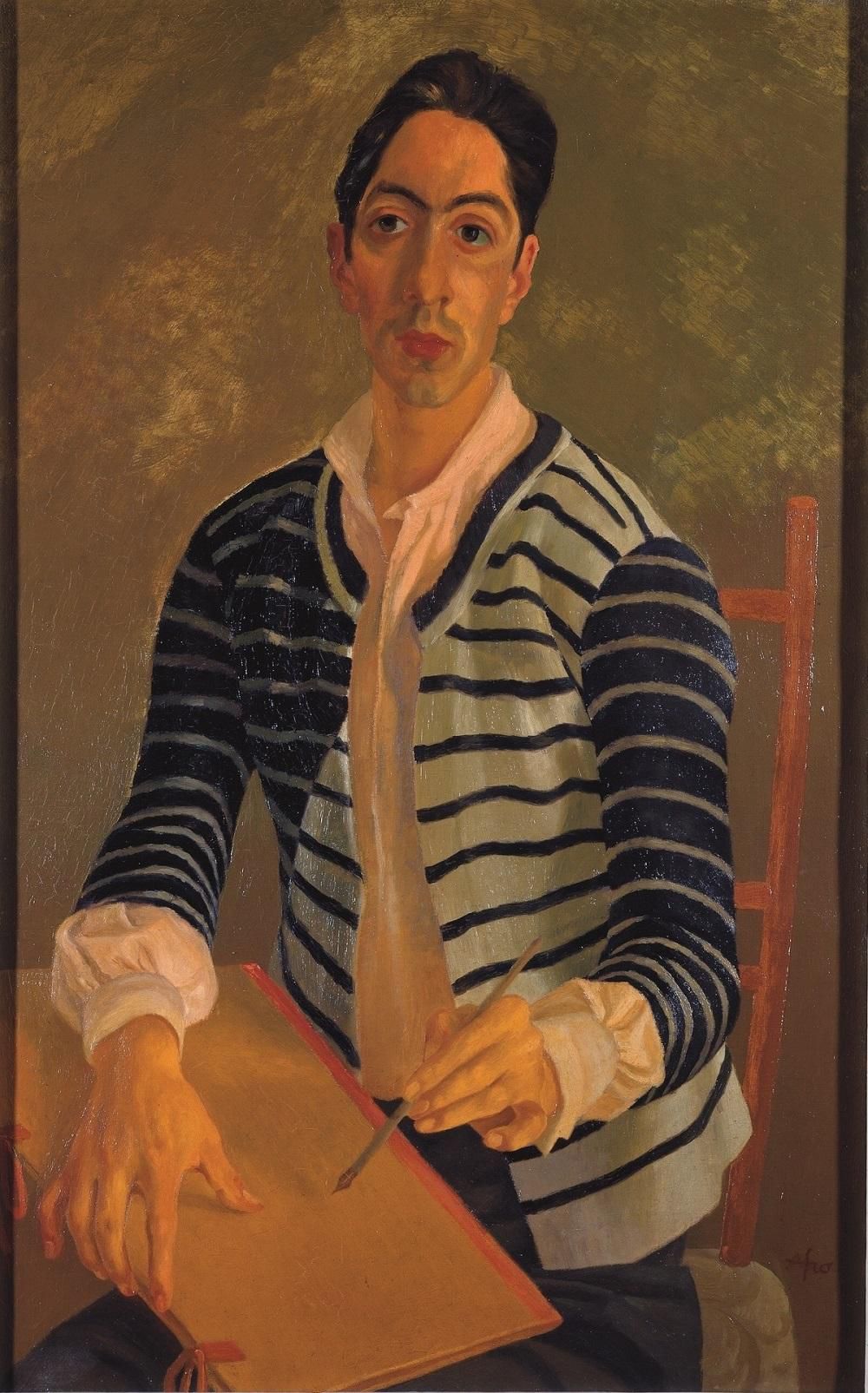
The 1936 self-portrait.
Afro Succession, Museum of Modern Art, Rome 2022.
It all starts in Ca Pesaro with a post-war period where Afro discovers abstraction, above all American. He then suffered a fascination for the other side of the Atlantic, where he ended up going and sometimes residing. Everything stays in the order of things, the US writers and visual artists allowing themselves to be disturbed at the same time by Rome, where some like Cy Twombly settle permanently. Afro is present at the new Biennials, at Documenta in Kassel (1959 and 1963) or in museums such as the Kunsthaus in Zurich. He rubs shoulders with Willem de Kooning, Philip Guston and Robert Rauschenbeg. Afro also admires Jackson Pollock. It is permissible to wonder if the thing does not lead to a misunderstanding. There is indeed nothing gestural in his very thoughtful painting. Very controlled. Very balanced. The Ca’Pesaro can thus show side by side one of its most accomplished canvases and its cartoon design. Not a line has changed between the project and the final realization, as in the time of Raphaël.

An Afro from 1952.
Afro Estate, Ca’Pesaro, Venice 2022.
This tribute to the painter, who died in 1976 in Zurich where he ended up living, offers almost all important works. Museums do not have to fight today to obtain his creations, as is the case for Matisse, Picasso or Rothko. There are few requests. Suffice to say that Afro finds himself in top form at Ca’Pesaro. His paintings are hung next to those of his contemporaries. Italians, of course, including Giuseppe Santomaso, Alberto Burri or Toti Scialoja. But also Americans, from Willem de Kooning to Franz Kline. The visitor can thus (or at least he could) judge the importance of the non-figurative transalpine production of the time, often passed under the leg. It’s curious… If the 1930s attract attention and if the “arte povera” of the 1960s retains it, there remains a great void between the two. As if nothing had happened between Turin and Naples during the 50s and 60s! Why, by the way?
Practice
“Afro, Da’ll Italia a l’America e ritorno, 1950-1970”, Ca’Pesaro, 2076 Santa Croce. Venice, until October 23. Such. 0 039 041 721 127, website www.capesaro.visitmuve.it Open Tuesday to Sunday from 10 a.m. to 6 p.m. No need to book.
Born in 1948, Etienne Dumont made studies in Geneva which were of little use to him. Latin, Greek, right. A failed lawyer, he branched off into journalism. Most often in the cultural sections, he worked from March 1974 to May 2013 at the “Tribune de Genève”, starting by talking about cinema. Then came the fine arts and books. Other than that, as you can see, nothing to report.
More informations
You found an error?Please let us know.
We wish to say thanks to the author of this post for this awesome material
Exhibitions in Venice – Surrealist magic bursts at Peggy Guggenheim
You can view our social media profiles here and other pages on related topics here.https://nimblespirit.com/related-pages/

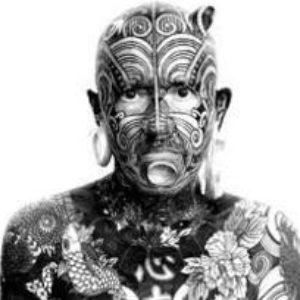
– Surreal magic erupts at Peggy Guggenheim
The current presentation studies the complex relationship between André Breton’s movement and the occult. It’s smart, well done and… very feminist.